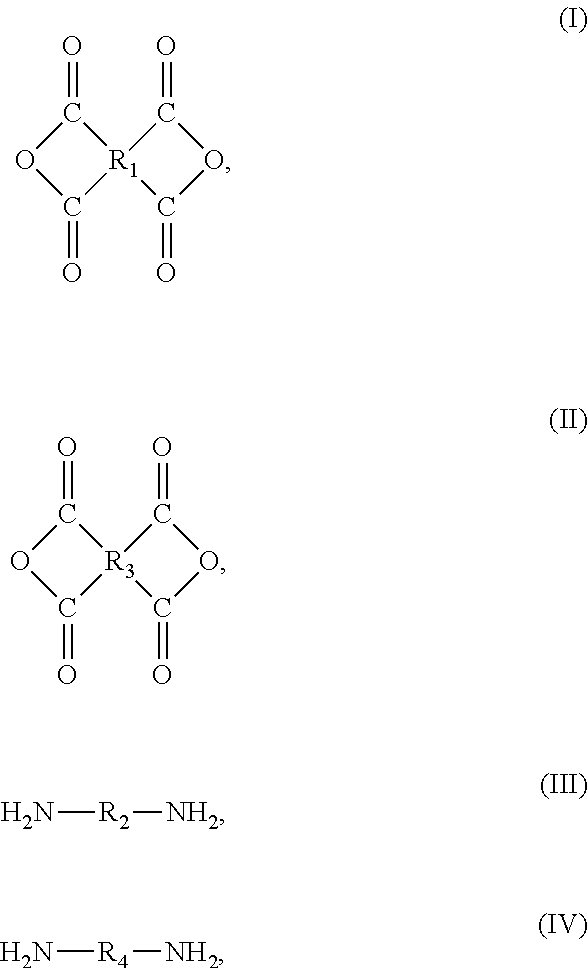Copolymide nano-fiber non-woven fabric, process for producing the same and the use thereof
- Summary
- Abstract
- Description
- Claims
- Application Information
AI Technical Summary
Benefits of technology
Problems solved by technology
Method used
Image
Examples
embodiment 1
[0032]One tetracid dianhydride monomer and two diamine monomers were selected as the comonomers. Purified biphenyl dianhydride (BPDA), p-phenylenediamine (PPD) and oxydianiline (ODA) were mixed at a molar ratio of 1:0.5:0.5, and reacted in N,N-dimethyl formamide (DMF) as a solvent following the above steps. In reaction step (1), the temperature of the reaction kettle of the example is 10° C., the time of the reaction under agitation is 6 h, and the electric field intensity of the high voltage electric field for the electrostatic spinning is 300 Kv / m; and in reaction step (2), the temperature rise program includes heating from room temperature to 200° C. at a temperature rise rate of 20° C. / min, and maintaining at the temperature for 30 min, heating to 350° C. at a temperature rise rate of 5° C. / min, and maintaining at 350° C. for 30 min, shutting off the power source, and naturally cooling to room temperature.
[0033]Property characterization: the mass concentration of the copolyamic ...
embodiment 2
[0034]One tetracid dianhydride monomer and two diamine monomers were selected as the comonomers. Purified pyromellitic dianhydride (PMDA), oxydianiline (ODA) and Benzidine (Bz) were mixed at a molar ratio of 1:0.6:0.4, and reacted in N,N-dimethyl formamide (DMF) as a solvent following the above steps; in reaction step (1), the temperature of the reaction kettle of the example is 5° C., the time of the reaction under agitation is 6 h, and the electric field intensity of the high voltage electric field for the electrostatic spinning is 250 Kv / m; and in reaction step (2), the temperature rise program includes heating from room temperature to 250° C. at a temperature rise rate of 20° C. / min, and maintaining at the temperature for 30 min, heating to 370° C. at a temperature rise rate of 5° C. / min, and maintaining at 370° C. for 30 min, shutting off the power source, and naturally cooling to room temperature.
[0035]Property characterization: the mass concentration of the copolyamic acid (p...
embodiment 3
[0036]One tetracid dianhydride monomer and two diamine monomers were selected as the comonomers. Purified pyromellitic dianhydride (PMDA), methylene dianiline (MDA) and oxydianiline (ODA) were mixed at a molar ratio of 1:0.5:0.5, and reacted in N,N-dimethyl formamide (DMF) as a solvent following the above steps; in reaction step (1), the temperature of the reaction kettle of the example is 5° C., the time of the reaction under agitation is 10 h, and the electric field intensity of the high voltage electric field for the electrostatic spinning is 250 Kv / m; and in reaction step (2), the temperature rise program includes heating from room temperature to 250° C. at a temperature rise rate of 20° C. / min, and maintaining at the temperature for 30 min, heating to 370° C. at a temperature rise rate of 5° C. / min, and maintaining at 370° C. for 30 min, shutting off the power source, and naturally cooling to room temperature.
[0037]Property characterization: the mass concentration of the copoly...
PUM
| Property | Measurement | Unit |
|---|---|---|
| Temperature | aaaaa | aaaaa |
| Temperature | aaaaa | aaaaa |
| Temperature | aaaaa | aaaaa |
Abstract
Description
Claims
Application Information
 Login to View More
Login to View More - R&D
- Intellectual Property
- Life Sciences
- Materials
- Tech Scout
- Unparalleled Data Quality
- Higher Quality Content
- 60% Fewer Hallucinations
Browse by: Latest US Patents, China's latest patents, Technical Efficacy Thesaurus, Application Domain, Technology Topic, Popular Technical Reports.
© 2025 PatSnap. All rights reserved.Legal|Privacy policy|Modern Slavery Act Transparency Statement|Sitemap|About US| Contact US: help@patsnap.com



